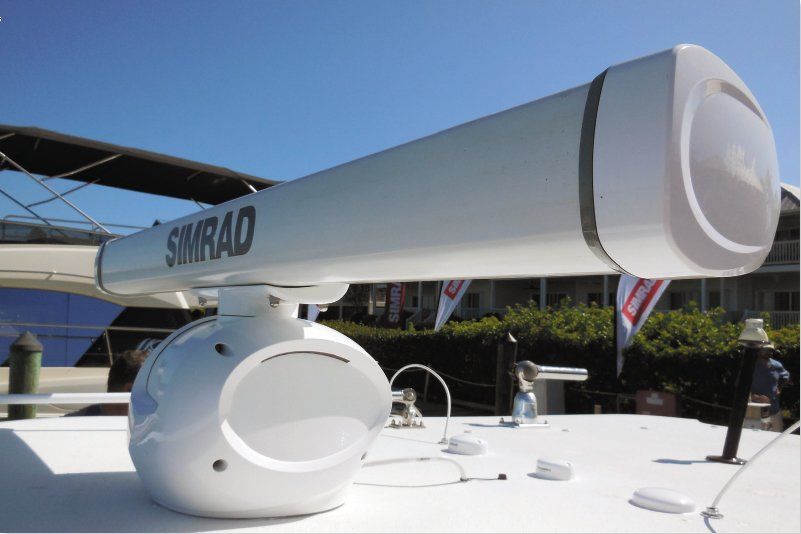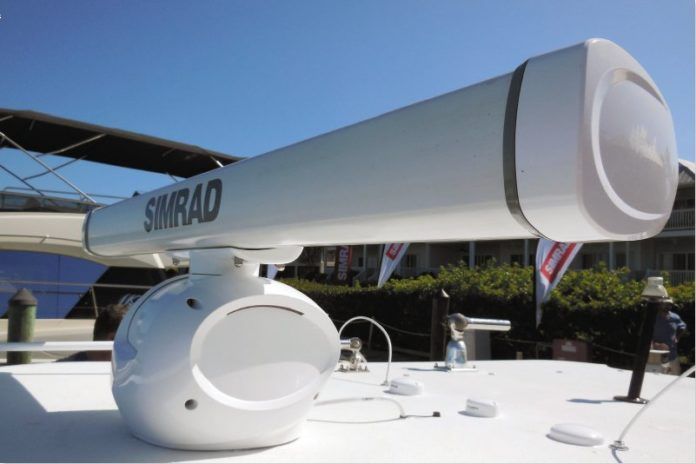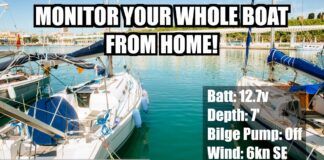Photos by Bill Bishop

Simrads Halo radar, an array radar system aimed at larger boats, exemplifies the rapid technological changes going on in marine electronics. Like CHIRP sonar, the sophisticated fish-finding technology that was once found only on research ships and is now available to everyone at West Marine, the Halo radar is redefining the level of technology that is within reach of the average cruising sailors budget.
Halo radar is significantly different from the conventional radar that is familiar to most sailors. It replaces the power-sapping Magnetron that is at the heart of older radar systems with an advanced gallium nitride (GaN) amplifier. Intelligent software processes signals and sharpens beams at faster-than-lightning speed. And the resulting images are the most detailed weve seen in any marine radar.
Halo Technology 101
Radar operates by sending out pulses of energy, receiving the echoes from those pulses, and processing these return signals into visual images. In general, short-duration pulses offer greater target resolution, but they can’t travel far. Longer pulses travel farther, but offer lower resolution. Rather than using the pulses employed by conventional radar, the Halo uses pulse compression, a burst-of-chirps approach that, in effect, combines the best of both worlds-offering higher resolution at both near and distant ranges.
The essential component in the Halo radar is the 25-watt gallium nitride amplifier, which allows the radar to produce the burst of microwave pulses. Until recently, this technology was found only in sophisticated military radar systems, but it is now making its way into the mainstream. Simrad is the first to include a GaN amplifier in its recreational radar line, although we expect other manufacturers to follow suit.
The GaN amplifier has a compact footprint, can operate in a wide range of temperatures, and according to Simrad, it will last for years and years. The companys engineers state that the amplifier is designed for more than 10,000 hours of life, several times longer than conventional magnetron-based radars.
How does Halo radar overcome the elements that limit pulse radar? The first part of its burst is just a single pulse with a very short duration (0.04 micro-seconds) followed by up to five more chirp pulses of 2 to 96 microseconds. Each pulse has a longer duration than the previous one. The extremely short duration of that first pulse means that the Halo has a very small main bang, the initial burst of energy that in other systems can blank out objects close to the radar antenna.
In typical radar, the area in which objects are rendered invisible or indiscernible by the main bang can extend as far as 20 to 30 meters from the boat. The main bang blind spot around the Halo radar, by comparison, is tiny, about 20 feet in diameter. The shorter chirps in each burst give the Halo radar excellent resolution of nearby objects, and the longer chirps in the burst provide the long-range clarity.
After the Halo emits its burst of chirps, it receives the echoes for digital processing. The speed at which Halo processes the data is impressive, about 200,000 times faster than chirp sonar, which uses similar technology. Halo requires these processing speeds because its handling six times the number of return pulses that conventional radar must process. In addition to handling multiple chirps simultaneously, the Halo also uses a patented process to sharpen its beam; this further enhances the images resolution. All of this high-speed data crunching is made possible by what is known as Field Programmable Gate Array (FPGA) technology, which only recently has become affordable for recreational boats.
This accelerated processing speed allows the Halo to carry out its most necessary feat: It must process each chirp individually and then stitch the resulting images together. So even though the longer-duration chirps create large-diameter main bangs, the blind spots created by these longer pulses are overwritten with the data from the shorter chirps. The resulting image looks exactly like a conventional radar presentation without the resultant dead zones or blind spots.
Halo Features
Currently, the Halo radar is available only in an open array, which leaves the spinning antenna exposed and more vulnerable to snagging halyards than an enclosed, dome radar. The antenna has a futuristic-looking, curved pedestal and is illuminated with blue LED lighting that you can control remotely from the multifunction display (MFD).
The antenna is currently available with 3-foot, 4-foot, and 6-foot diameters, and the system integrates with Simrads NSS/NSO EVO line of chartplotters. The Halo open-array radar can be fired up and ready for use in 16 to 25 seconds. Compared to conventional radar, its signal emissions are very low. The transceiver/antenna weighs 52 pounds, which is comparable to similar-sized conventional radars, but more than the compact radars weve previously tested.
The Halo is capable of interfacing with two fully independent, dual-range displays, each with individual customization. It can track up to 20 MARPA targets. Like the more traditional radars, Halo has operational modes that include harbor and offshore sea states. It also has weather (colored to show intensity of rain) and bird modes. Used to locate feeding birds that might indicate fish below, the bird mode demonstrates the radars two most potent capabilities-high-resolution imaging and target separation. During our on-the-water testing, a dozen seagulls about three-quarters of mile away were clearly visible on the display and just barely discernible by eye.
Radar enthusiasts who can’t restrain the urge to fiddle with gain control will be disappointed to find that the amount of customization for each of these modes is limited. However, the unit we tested worked well in its auto modes. There are additional modes in the works, including buoy, net-finder (for commercial fisherman), SART (Search And Rescue Transponders) beacon, and radar beacon (RACON) modes.
Target resolution was excellent, both at close range and at maximum range. We were able to clearly see day marks that were only about 25 feet away and at the same time pick out small boats that were several miles away. The close-in visibility was notable, and the radars small main bang will make life easier for sailors operating in confined areas with poor visibility.
The system also is very quiet. Sealed bearings and a brushless DC drive system make it hard to hear whether the array is spinning or not.
Power Use
The amount of power required for an open-array radar during operation (as opposed to standby mode) varies depending on the wind, which creates friction on the spinning antenna, and the type of system. Most manufacturers report typical or average power usage values, making it difficult to compare power consumption. The Halo definitely uses less power than a conventional magnetron-based system, and it lies at the lower end of the spectrum when compared to other digital radar systems.
According to Simrads numbers, the Halo with a 4-foot array in standby uses .54 amps at 12 volts. With the radar transmitting in no wind, the 12-volt Halo uses 3.3 amps. When using the dual-range mode, the additional signal processing loading can increase the power usage slightly. The typical magnetron draws at least one amp while in standby mode and between 7 and 10 amps while transmitting.
Installation
Installing the Halo is straightforward. The pedestal and antenna are attached to the boat, and a single, small-diameter cable (available in lengths from 10 meters to 30 meters) connects the radar to Simrads RI-12 radar interface module, which is mounted in a dry area. The Halo also has two cable attachment points, one for each of the most common types of pedestal mounts: behind the unit or directly underneath; this helps to reduce cable exposure to UV and prevent any water intrusion. The interface module connects to ships power (12 to 24 volt DC). An Ethernet cable connects the radar interface module to the MFD network, and the RL-12 module is connected to ships power. The entire system is essentially plug and play.
The radar setup is menu-driven. One important data point that needs to be entered is the height of the antenna to the water. This measurement is used to optimize the settings for sea clutter and other modes. You can also set up the system for sector blanking. This tells the unit to not transmit in up to four specific directions. For example, to reduce reflected noise, a mast-mounted system can be set to not transmit a signal in the direction of the mast. Installation instructions are clear, well written, and easy to follow.
Conclusion
Simrads new Halo radar is very impressive high-performance technology with an intuitive and user-friendly interface. The package is relatively simple to install. Although open-array radar systems are better suited to larger sailboats, the 3-foot diameter Halo version requires only about six more inches of clearance than you would need with a 24-inch radar dome-although the Halos extra weight is another drawback. Given the general trends in the marine electronics industry, we think its just a matter of time before smaller, lighter dome versions-a better fit for the average cruising boat-begin to appear on the market.
The Halos online prices start at $4,500 for the 3-foot antenna version, which has a maximum range of 48 nautical miles. Prices are very competitive with other marine radar products, especially given the substantial capabilities. This is technology worth keeping an eye on.




































